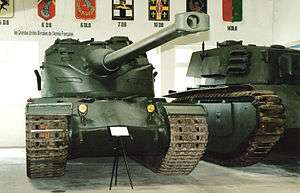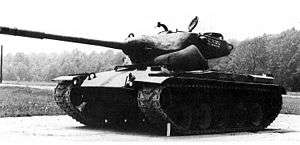Oscillating turret
An oscillating turret is a form of turret for armoured fighting vehicles, both tanks and armoured cars. The turret is unusual in being made of two hinged parts. Elevation of the gun relies on the upper part of the turret moving relative to the lower part.
Oscillating turrets have only rarely been used. Their only widespread use was on two French designs: the AMX-13 light tank and the Panhard EBR armoured car; the Austrian SK-105 Kürassier uses a turret developed from the AMX-13.[1]
Design


The turret consists of upper and lower parts, joined by a trunnion. The gap between these two parts is often covered by a distinctively visible rubber or canvas bellows.
The gun itself is fixed to the upper part of the turret. Elevation of the gun is achieved by tilting the entire upper part of the turret. In conventional designs, the gun is tilted by running on its own trunnion, while the turret remains fixed to the fuselage. Traverse is achieved conventionally, by rotating the turret.
In oscillating turrets where the oscillating part of the turret is enclosed gives the advantage that the gunner and loader always is in line with the gun allowing easier aiming and loading.
Advantages
There are three major advantages: high gun placement, smaller turret size and simpler fitment of an autoloader.
In a conventional design, the turret has to have room above the breach to allow it to rise to tilt the gun down. An oscillating design moves the turret with the gun, so no extra room is needed. This allows the gun to be at the very top of the turret. This reduces the amount of the turret that is exposed when the tank is in a hull-down position, as well as improving the possible depression angles.
Additionally, the breach of the gun falls into the tank when it elevates, which requires the turret ring to be large enough to allow this motion. In an oscillating design, the breach is always above the turret ring. This allows it to be smaller, potentially allowing the hull to be smaller as well. However, in this case, the maximum elevation angle is defined by the space between the rear of the turret and the deck of the hull, which may be less than the angle possible in a conventional design where the breach can fall into the hull.
For this reason, oscillating designs often have the gun mounted higher above the deck in order to improve the possible elevation angles. This makes the turret taller than on conventional designs, which may make it more difficult to find protective cover as well as making it more visible on the battlefield. However, this is offset slightly by the fact that the lower hull position relative to the gun may allow better protection in the hull-down position.
Other improvements include the fact that the gun sights are generally more in-line with the gun, and that it is easier to fit an autoloader mechanism as the breach remains in the same position relative to the loader.
Compact turrets
Heavy tanks and the AMX-50

The initial claimed advantage of oscillating turrets was that of reducing the turret size for a large main battle tank gun. In the 1950s, tanks were rapidly growing more heavily armed, larger and heavier. Western armed forces were trying to catch up with the increasingly formidable Soviet tanks, such as the T-55. Weight was the main problem, particularly where this then required extra engine power and stronger transmission. As the thickest armour is generally on the turret, reducing turret size appeared to be a worthwhile goal.
Size may be reduced because the non-elevating gun breech does not need to move up and down inside the upper turret. Working space thus does not need to be allowed for it above or below the breech, space that is normally wasted in conventional turret designs. In particular, the oscillating turret design is particularly shallow above the breech, allowing for a low turret silhouette, a considerable advantage.
This was the justification for the first oscillating turret, that of the French AMX-50 medium or heavy tank in the 50 tonnes class. This used first a 90 mm, then 100 mm, gun in an oscillating turret, primarily to save weight. The final 120 mm version first reverted to a conventional turret, but then used another oscillating design, the Tourelle D. However the need to elevate the gun still requires room for the breech to be lowered into the lower turret. This has tended to produce oscillating turret designs with a high gun axis relative to a conventional turret, even where the turret height is otherwise shallow.
One problem was that the armour of a turret is primarily in the front face of the turret and this was not made any smaller in the AMX-50 design, the turret of the 120 mm version being so tall as to be reminiscent of the WW2 Challenger, the turret being a whole foot taller than the contemporary and comparably armoured Conqueror. The AMX-50 grew progressively heavier and although it might have proved a capable heavy tank by 1950s standards, this whole class of slow-moving AFV was becoming outdated by the development of lightweight anti-tank guided missiles in the 1960s and so the project was abandoned.
Light tanks

Whilst the oscillating turret was unsuccessful for the heavy tank, it proved more successful in allowing light tanks and armored cars to carry an unusually heavy main gun of 90 mm. In French doctrine, light reconnaissance vehicles were heavily armed and expected to also fulfill a role in defending the flanks of a main force. They were not expected to act as tank destroyers though, and so a high-caliber but relatively low velocity gun with high-explosive shells was effective in their role.
Auto-loading
As the gun remains fixed relative to the upper turret, it is easier to install an autoloader than for a conventional turret, where the gun must return to a fixed elevation for reloading. The French design used two six-round rotating magazines, allowing a high rate of fire and also a selection of two ammunition types. The disadvantage was that once the magazine ready capacity was used, reloading of the magazines was a slow process requiring the vehicle to rest and crew to operate outside the vehicle, which could not be carried out under fire.
As was so often the case with the early autoloaders though, their complexity was their downfall. The 120mm for the AMX-50 was simply unreliable, due to the weight of the ammunition round.
AFVs fitted with oscillating turrets
- French
- AMX-13 – Widely used light tank[2]
- AMX-50 – Heavy tank, prototypes only
- Panhard EBR – Armoured car
- Austrian
- SK-105 Kürassier – Used the 105 mm FL-12 turret of the AMX-13[3]
- German
- Kugelblitz - Mounted dual 30mm MK 103 cannon in a novel oscillating ball mount.
- Egyptian
- Sweden
- United States
- T71 - One wooden prototype built
- T69[5]
- T54E1 Tank, Heavy, 105mm Gun – Two prototype vehicles with 105mm guns and autoloaders were constructed on the M48 tank chassis. They were constructed around 1952 by United Shoe Manufacturing.[6] One T54 had a conventional turret, the other T54E1 an oscillating turret.[7]
- T57 Tank, Heavy, 120mm Gun – A single prototype was constructed in the 1950s on a M103 heavy tank chassis, with a 120mm gun in an oscillating turret.[8]
References
| Wikimedia Commons has media related to Oscillating turrets. |
- ↑ "Panzer", Robert Jackson, Parragon Books ISBN 978-1-4454-6810-5
- ↑ "Armoured Fighting Vehicles". AMX-13. Jane's Weapon Systems. 1977. p. 300. ISBN 0-354-00541-3.
- ↑ Jane's Weapon Systems, 1977, p. 295
- ↑ http://tanks.mod16.org/2013/12/07/project-emil-a-summary
- ↑ R. P. Hunnicutt. Patton: A History of American Main Battle Tank Volume I. — Presidio Press, 1984. — ISBN 0-89141-230-1
- ↑ Haugh, David R. (1999). Searching for Perfection. Portrayal Press. p. 66. ISBN 0-938242-33-4.
- ↑ George F. Hofmann; Donn Albert Starry (1999). Camp Colt to Desert Storm: the history of U.S. armored forces. University Press of Kentucky. p. 307.
- ↑ Haugh, 1999, p. 67
- Further reading
- Lau, Peter (2007). The AMX-13 Light Tank. Volume 2: Turret. Rock Publications.
.jpg)
